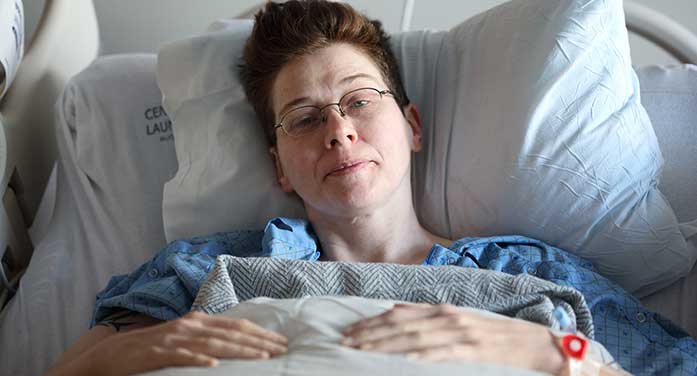Digoxin shows potential as a treatment for endometrial cancer
A team of researchers at the University of Alberta has found that digoxin, a drug widely used to treat congestive heart failure, is an effective therapy for a rare and aggressive form of endometrial cancer.
The findings, published in the July issue of the journal Gynecologic Oncology, surprised the researchers, says Cheng-Han Lee, associate professor in the Department of Laboratory Medicine & Pathology and Sawin-Baldwin Chair in Ovarian Cancer.
“People had begun to uncover the anti-cancer role of digoxin about a decade and a half ago,” says Lee, who was senior author on the study. “But they never figured out why it seemed to work on some cancers and not others, so it was difficult to translate the findings to clinical practice.”
 Cheng-Han Lee |
 Lynne Postovit |
The new U of A study, the master’s thesis of graduate student Pooja Praveen Kumar, involved collaboration with scientists at the University of Saskatchewan and the University of British Columbia. The researchers used surgical tissue samples from patients with a highly aggressive type of endometrial cancer to create three-dimensional laboratory cell models that closely resembled how cancer cells would behave in humans.
They tested hundreds of drug compounds that might work to control the endometrial cancer cells using a robotic platform at the Saskatchewan Cancer Agency.
Digoxin, along with several other drugs in the cardiac glycoside compound family, was identified as a promising drug candidate. The findings are critical because the current chemotherapy drug widely used for endometrial cancer doesn’t work on this highly aggressive subset, known as dedifferentiated endometrial carcinoma (DDEC).
Endometrial cancer is found in the inner lining of the uterus and is the most common gynecological cancer in Canada, according to the Society of Gynecologic Oncology of Canada. An estimated 8,600 Canadian women will be diagnosed with uterine cancer this year, more than 90 percent of which are endometrial.
Though the five-year survival rate for most endometrial cancer is as high as 90 percent if the disease is found early, the prognosis for women with the DDEC subset is dire. Although it makes up only about two percent of endometrial cancers, the 100 percent mortality rate means finding a treatment is crucial.
“With a lot of cancer we study, we plot the median survival in years,” says Lee. “With this one, it’s only three or four months median survival. So it’s terrible.”
Lee, who received his MD-PhD degree and pathology residency training at the University of British Columbia, started studying this rare cancer in 2013 during an earlier stint at the U of A, working with the previous Sawin-Baldwin Chair, Lynne Postovit. They used next-generation genetic sequencing technology to understand the unique molecular biology of these tumours, which could explain why they kill patients so quickly.
That research provided the foundation for the new study. The researchers expect to present their findings to clinical trial groups in Canada and the United States, hoping that an organization might consider using digoxin on patients in a trial. But that process could take years, Lee stresses.
The immediate next step for Lee’s team is a two-year project, funded by the Cancer Research Society, to understand how digoxin kills the aggressive DDEC cancer cells.
“It’s almost like we are repurposing this drug because it has an unexpected anti-cancer effect against this cancer,” Lee says. “If we understand how these cancer cells are vulnerable to the drug, then we can ask the question: is there a more specific way to target this?”
Lee is also curious to know whether there could be other drugs that would be even more effective than digoxin, or whether digoxin could be combined with another drug to make it better tolerated. One possibility would be looking at combining digoxin with doxorubicin, already used as a second- or third-line treatment for endometrial cancer.
The research could have broader implications beyond this rare type of endometrial cancer, adds Lee, who is a member of the Women and Children’s Health Research Institute and the Cancer Research Institute of Northern Alberta.
“I’m optimistic that through studying the mechanisms involved in why this endometrial cancer is vulnerable to this drug, we will be able to learn more about how to treat other aggressive cancer types.”
| By Keri Sweetman
This article was submitted by the University of Alberta, a Troy Media Editorial Content Provider Partner.
Explore more on Women’s Health, Cancer, Ovarian cancer, Breast cancer
The opinions expressed by our columnists and contributors are theirs alone and do not inherently or expressly reflect the views of our publication.
© Troy Media
Troy Media is an editorial content provider to media outlets and its own hosted community news outlets across Canada.


